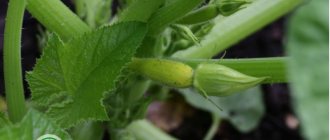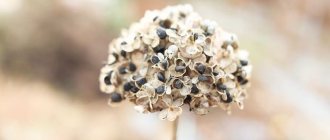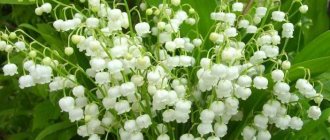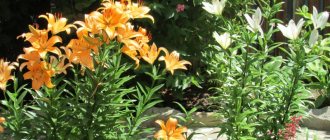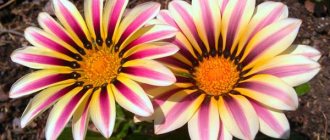Author: Natalya Category: Garden plants Published: February 21, 2019Republished: February 21, 2019Last edits: January 20, 2021
- May lily of the valley (Convalaria majalis)
You can guess the lily of the valley by its smell with your eyes closed. This forest flower is so adored that many people move it to their gardens and summer cottages. The Egyptians began cultivating lily of the valley more than two thousand years ago, and achieved serious success in this: their lilies of the valley bloomed all year round. Unfortunately, these spring flowers are becoming less and less common in nature, and many of their species are listed in the Red Book. Therefore, it is advisable to grow lilies of the valley in cultivation, and we are ready to provide you with all the necessary information about:
- where, when and how to plant lilies of the valley in the garden;
- how to care for them during the season;
- how to prepare lilies of the valley for winter.
Planting and caring for lilies of the valley
- Planting: from September to early November.
- Flowering: April-May.
- Lighting: partial shade, shadow.
- Soil: moist, rich in organic matter, neutral or slightly acidic.
- Watering: only in abnormally hot times.
- Top dressing: humus or rotted manure, solutions of organic or mineral fertilizers.
- Reproduction: mainly by dividing rhizomes, less often by seeds.
- Pests: sawflies, nematodes, onion borers.
- Diseases: gray vegetable rot, gleosporiasis.
- Properties: lily of the valley is poisonous.
Read more about growing lilies of the valley below.
Lily of the valley (lat. Convallaria) is a monotypic or oligotypic (including a small number of species) genus of the Asparagus family. Not so long ago, the lily of the valley flower was classified as a member of the Lily family or allocated to the Lily of the Valley family. The Latin name Lilium convallium, which was given to the plant by Carl Linnaeus, translates as “lily of the valleys.” The Russian name “lily of the valley” most likely came from the Polish language, and this plant is also called rejuvenator, rejuvenator, culprit and shirt. In the wild, lily of the valley is a forest flower; it grows in Europe, Asia and North America in deciduous, pine, mixed forests and floodplain oak forests.
Lily of the valley has been cultivated since the 16th century; in some towns in France, on the first Sunday in May, a lily of the valley festival is held. The healing properties of lily of the valley have been known since time immemorial and are still used in both traditional and folk medicine. Lily of the valley is also in demand in the perfume industry for creating fragrances.
What does the May lily of the valley (Convallaria majalis) look like?
After a long winter, the appearance of lilies of the valley heralds the arrival of spring. In central Russia this occurs in May. Despite its external fragility, the flower is quite strong. Even very dense soil and rocky surfaces are no barrier for it. Under favorable conditions, single plants can grow and cover even large areas with a carpet.
May lily of the valley
The description of the May lily of the valley can begin with the leaves. Tight rosettes of elongated leaves appear first. True, the number of one plant does not exceed three leaves. Most often two. They grow directly from the base of the root system, and in the middle, from a large bud, a peduncle grows. It contains from 5 to 20 small bells on legs. The buds have teeth at the top and bottom.
Which family does it belong to?
A member of the asparagus family, Convallaria is a herbaceous perennial. Until now, experts have not decided on the subtype of the flower. Some suggest subdividing them into Keizke lily of the valley and Gorny. But their similarity makes it possible to classify both subspecies as one species - the May lily of the valley family.
Briefly about the history of appearance
The first mentions of these elegant flowers date back to the 15th century. Since then, they have been bred for the beauty of their flowering brushes, emerald leaves and, of course, their amazing aroma. The distribution is wide. Lily of the valley grows on all continents. Unlike many plants, the type of forest, type and quality of soil are not important for it.
It grows well on the edges of:
- deciduous forests;
- pine plantings;
- oak forest;
- mixed forests.
Tolerates poor soil well. It has long been a favorite crop for breeding.
In its natural environment, this flower has been destroyed by humans for centuries. Whether lilies of the valley are in the Red Book or not is clear from their widespread disappearance in the wild.
Plant characteristics
The life cycle of the culture is 12-13 years. The first flowering occurs in the seventh spring. After three years, the peduncle is no longer produced and the plant can no longer bloom. After another couple of years, the bush falls apart, forming a large number of new ones.
Lily of the valley plantation
The leaves of the plant are rich emerald color, oblong in shape. The tips of the leaf blade are pointed. The plant, together with the peduncle, grows in height up to 25-30 cm.
Cultivated varieties can reach up to 50 cm. In autumn, orange-red berries up to 1 cm in diameter ripen from the buds. When asked whether lilies of the valley are poisonous or not, the answer is definitely positive. Lily of the valley is a poisonous plant!
Need to know! Lily of the valley berries are poisonous.
Lily of the valley has a unique root system. It is very developed horizontally. From the nodes on the rhizome small leaves grow, which over time turn into young bushes.
Botanical description
The lily of the valley plant blooms in May-June for about two weeks. It reaches a height of 20-25 cm. The rhizome of lily of the valley is thin and creeping, numerous roots have a fibrous structure. The leaves of the lily of the valley, of which there are from one to three, are oval-oblong, broadly lanceolate, retain a lush green color until the end of July, then turn yellow and wither. The peduncle of the lily of the valley, which is formed from a flower bud, has a triangular cross-section in its upper part and is twisted in a spiral. Snow-white, fragrant, clustered flowers of 8-12 pieces are small bells 4 mm long and 5 mm wide with short stamens. By the end of flowering, the lily of the valley inflorescence darkens, the ovary appears - three-chambered lily of the valley berries, each of which contains 3-6 seeds. Lily of the valley seeds are poisonous, like the rest of the plant.
- Yucca at home
Description of lily of the valley
May lily of the valley (Convallaria majalis) is a perennial herbaceous plant with a creeping branched rhizome and thin roots at the nodes. The underground rhizome is no thicker than a goose feather; near the top it bears several pale small lower leaves, half hidden in the ground.
From the tops and lateral branches of the rhizome shoots arise, consisting of 3-6 vaginal leaves. The leaves of the lily of the valley are basal, long-petiolate with an oblong-elliptical pointed leaf blade, thin, entire, bright green, bluish on the upper side and shiny on the lower side.
The flower arrow of the lily of the valley is smooth, triangular in the upper part, 15-20 cm high. The perianth is snow-white with slightly bent six teeth. Inside the flower, the pistil is surrounded by six stamens on short filaments attached at the base of the perianth.
The plant has a strong but pleasant aroma and blooms from late May to June.
The fruit is a juicy three-lobed spherical orange-red berry that ripens in August-September.
Attention! The entire lily of the valley plant is poisonous; it contains convallatoxin, a poison of plant origin. Lily of the valley berries have the highest concentration.
Features of growing lilies of the valley
Lilies of the valley are shade-tolerant. They are listed in the Red Book. Not only the fragrant flowers are beautiful, but also the wide dark green leaves of the lily of the valley. Lilies of the valley go well in the garden with ferns, lungwort, aquilegia, and anemones. Lilies of the valley grow incredibly quickly, and can crowd out any other flowers in a flowerbed. They behave the same way in prefabricated bouquets: other plants quickly fade in the vicinity of them. All parts of the plant are poisonous, so be careful when working with lilies of the valley.
Protecting lilies of the valley from pests and diseases
To successfully grow lilies of the valley in the country, do not forget that you need to take care of protecting plants from pests and diseases. Of the pests, the real damage is caused by two close relatives - the onion rattle and the lily rattle. These elegant bright red oval bugs, 6-9 mm long, are distinguished by their extraordinary gluttony. Often traces of their activity are noticed on lilies, which they, together with their larvae, literally skeletonize, leaving only one skeleton. The larvae are simply disgusting - thick, brownish-orange, covered in dark mucus from their own excrement.
Until the beetles have bred on the lilies of the valley, they can be collected by hand, but this must be done often and collected carefully, because at the slightest danger they fall to the ground. You need to look for larvae on the underside of the leaves. If there are a lot of pests and manual collection does not solve the problem, you need to use insecticide solutions: Aktara, Konfidor, Zubr, Komandor, Decis, Kinmiks and others.
Nematodes are also dangerous - microscopic worms that attack the stems and rhizomes of lily of the valley. The plant looks depressed, necrotic spots appear, and if measures are not taken in time, it dies. If the damage is severe, then the lilies of the valley need to be dug up and destroyed.
When growing lilies of the valley in the country, as a preventive measure, it is good to plant several marigold bushes next to the curtain. But most importantly, you should carefully inspect the planting material and rinse the sprouts with warm water (45-50 degrees) before planting.
In rainy weather in mid-summer, gray rot may appear on the leaves of lilies of the valley, which looks like a gray coating. Gradually it thickens, becomes fluffy in appearance, the tissues of the plant soften and it rots.
The main reason for the appearance of gray mold is: heavily thickened plantings, excessive compaction and waterlogging of the soil, and excessive application of nitrogen. For minor lesions, solutions of Topaz and Alarin-B are used. If the plant is severely affected, it will have to be destroyed so as not to infect the entire lily of the valley plantation.
Sometimes lilies of the valley are affected by purple spotting, as evidenced by red-edged spots and wounds on the leaves. The disease is fought with the same means as gray mold.
Planting lilies of the valley and caring for the garden
When to plant
If we are talking about when is the best time to plant lilies of the valley in open ground, then any gardener will answer you unequivocally: in the fall, from early September to early November. The most suitable place for them is under trees or bushes, which will create the shade they need for lilies of the valley, preventing the sun from quickly drying out the soil in the area. But remember that these plants still need light, otherwise the area will turn beautifully green, but you won’t see any flowers. And think about how to protect lilies of the valley from the wind.
Lily of the valley requires moist, slightly acidic or neutral soil, rich in organic matter. Let us remind you: in order to reduce the acidity of the soil, lime (200-300 g per 1 m²), humus or peat compost (10 kg per 1 m²), as well as fertilizers: 100 g of superphosphate and 40 g of potassium sulfate per 1 m², and you need to prepare the soil for autumn planting of lilies of the valley in the spring.
Autumn planting
Lilies of the valley are planted in rows in grooves, maintaining a distance of 10 cm between specimens, and 20-25 cm between rows. We will not describe how lily of the valley seeds are sowed: lily of the valley seeds have a very low germination rate, and such lilies of the valley grow for a very long time, and division rhizomes produces high-quality planting material - sprouts with part of the rhizome and root lobe. Some of the sprouts bear a flower bud and may bloom next spring - these are sprouts with a diameter of at least 0.6 cm with an oval tip. And those that are smaller in size and have a sharp tip next year will only be able to produce leaves.
The depth of the furrow should be such that the roots are placed vertically, in full length, and the sprouts are buried 1-2 cm into the ground. If the soil on the site is dry, do not forget to water the lilies of the valley after planting. With the onset of frost, cover the area with young lilies of the valley with mulch to protect them from freezing in case of a snowless winter. Lily of the valley can grow in one place without transplantation for five years.
Lilies of the valley in spring
You can plant lilies of the valley in the spring, but they can get sick and definitely won’t bloom this year. But if you prepare the area in the fall, as described above, and dig it up in the spring before planting, then the young shoots will more easily take root in the open ground, especially if you cover them with film or lutrasil at night, protecting them from spring frosts.
- Astrantia: growing from seeds, types and varieties
How to care
Lilies of the valley take care of themselves so well that they can crowd out any other flowers from the flowerbed, but for a good gardener it is not enough that the flowers grow and bloom, he needs his plants to achieve the highest decorative quality. Therefore, you will also have to pay attention to lilies of the valley: water them in hot weather so often that the soil remains moist all the time, be sure to loosen the soil and remove weeds. Lily of the valley responds well to fertilizing with organic matter - rotted manure or humus. Lilies of the valley can develop gray vegetable rot, which can be treated with fungicides.
Of all the pests, the most terrible is the nematode, from which there is no escape: diseased plants are removed and burned. This is why weed control in the area where lilies of the valley grow is so important.
Choosing a landing site
Those who are going to grow this plant on their plot become real saviors. Due to constant deforestation and indiscriminate collection of flowers for medicinal purposes, lilies of the valley are gradually disappearing, and today they are listed in the Red Book.
It seems to many. That lilies of the valley are everywhere, although their population is rapidly disappearing. They grow in colonies and reproduce easily. But by picking even one stem, you can destroy the entire colony at once. Therefore, it is undesirable to collect this plant without certain knowledge.
Variety Aurea
To grow a plant on your site, you should carefully choose a suitable location. Of course, lilies of the valley are not quite picky, but shaded places are best suited for them. In the shade, away from direct sunlight, the flowering period can increase to 5 weeks.
Lilies of the valley are considered aggressive. Due to its rapid reproduction and stability. In just a couple of months, they can turn from a couple of small sprouts into a huge colony, literally eradicating any other plant from the garden. To prevent the front garden from becoming overgrown with lilies of the valley, it is necessary to create certain conditions for them: the boundaries of the flower bed are determined by stones, bricks, sheets of slate or metal. They should go at least 30 cm into the ground to prevent the root system from spreading wider than this limit.
Many people create decorative flower beds with lilies of the valley in separate containers. If necessary, they can easily be moved to the shade, or removed to another place as soon as they bloom.
The soil
For lilies of the valley, it is advisable to prepare the soil in advance . Many do this a year in advance, others prepare the substrate for planting in the spring. For this plant, slightly acidic soil, well-drained, medium to lightly dry, slightly moist, and cool is best suited. The cultivated layer of soil for a flower bed for these flowers is at least 25 cm.
Plants in open ground
If the soil is highly acidic, it must be limed in advance.
The soil also needs to be fertilized with peat compost, humus or manure . You can supplement this with potassium sulfate or superphosphate. Before planting, the soil must be loosened. In order for the plant to take root and develop well, it must be dug all summer, getting rid of weeds.
Dates and methods of planting
As a rule, the plant is replanted entirely, but lilies of the valley can be grown from seeds.
Germination of seeds
The method of dividing rhizomes is also often used.
When to plant
The best time to plant lilies of the valley is autumn. But if you replant the plant in the spring, the chance that it will take root is also very high.
If you choose autumn, then you should start planting at the end of August or September. It is best to do this in a place where peas or legumes previously grew. They saturate the soil with organic matter and nitrogen. Therefore, before planting lilies of the valley, it is worth removing all the green legumes and digging up the roots with soil.
Lily of the Valley Convallaria Majalis
April or May are best for spring planting . At this time, finding a specimen for planting will not be difficult. But this time promises various diseases for lilies of the valley. Of course, the plant will easily take root if the soil has been prepared in the fall.
If you planted lilies of the valley in winter, to increase their chances of taking root, you need to cover the young shoots with polyethylene, thereby hiding them from frost. Fortified plants are no longer afraid of the cold.
Step-by-step instruction
Flowering plant
- We start with preparing planting material. We select roots with round and large buds. We divide them into segments of 3-5 cm, each of them should have bud eyes at the top.
- There is no need to make beds. We simply dig up a strip of earth (at least 20 cm) in a previously prepared place.
If there may be stagnation of liquid in this place, this must be prevented by making something like a drainage out of ordinary stones.
- Let's return to the roots. On each segment you need to shorten the thin roots a little.
- In the dug area, we make holes 3 cm deep, at a distance of at least 25 cm from each other.
- You can add some fertilizers to the holes, or fill them with humus.
When filling the roots, remember that the layer of soil above them should be no more than 2 cm.
The grass can begin to bloom by May. It lasts on average 2 weeks, but some varieties can boast a flowering period of up to 3-5 weeks.
How to care
After planting, the plant will have a rooting phase for about a month . At this time, the soil needs to be fed with organic matter. It is better to avoid chemicals and mineral fertilizers. It is advisable to use minerals only after a year, when the lilies of the valley have completely taken root. But chemicals are not needed for this herb at all due to the unpretentiousness of the plant.
Lilies of the valley in home decor
The most important rule is to water the plant regularly . The hotter the weather, the more often you need to moisten the soil. Despite this, lilies of the valley do not like excessive dampness, so it is important not to overdo it with watering.
Flowers need to be regularly removed from weeds . Many experienced gardeners recommend doing this by hand. It is also important to loosen the soil regularly.
Although wild animals love to eat lily of the valley berries, all parts of the plant are poisonous and contain canvallatoxin. It is the berries that have the maximum content of this poison, so consuming them is strictly prohibited. It is also important to ensure that small children do not play with the leaves, flowers, and especially the fruits of the plant. It is also important to remember that any procedures, be it planting or watering, must be carried out with gloves. Also be careful about placing these flowers in your home. Lilies of the valley should not be in the bedroom, as this can cause headaches.
Lilies of the valley after flowering
Lilies of the valley fade at the beginning of summer, but, having lost their fragrant inflorescences, they decorate the area with their wide dark green leaves for some time. To prevent lilies of the valley from taking over someone else's territory, fence the flowerbed with sheets of slate, digging them 40 cm into the ground.
When autumn comes, start replanting lilies of the valley, if the time has come, and if replanting is not planned this year, forget about lilies of the valley and move on to other flowers - lilies of the valley are frost-resistant, and nothing will happen to them in winter. When spring comes and the snow melts, use a rake to remove last year's dry leaves from the lily of the valley flower bed and wait for the first lilies of the valley to appear.
Reproduction of lilies of the valley
author Ziborova E.Yu. photo Ziborov T.Yu.
Lily of the valley, delicate, fragrant, is one of the favorite flowers, the appearance of which everyone looks forward to in the spring. After the lovely bells of lilies of the valley have faded, the moist shady corners of the garden are decorated with a cover of their large light green leaves and orange fruits. It is not surprising that gardeners are happy to grow a variety of lilies of the valley in the garden - silver-white and pink, simple and double.
August is the time for propagation of lilies of the valley by dividing rhizomes. A planting unit (sprout) of lily of the valley should consist of a section of rhizome with roots and one (or several) apical buds. Sprouts aged 1-2 years are used for vegetative propagation of lilies of the valley; three-year-old sprouts will delight you with flowering next spring. Lilies of the valley grow wonderfully in loose, breathable, moisture-retaining, nutritious soil in partial shade.
Lilies of the valley can also be planted in spring; Sprouts dug up in the fall are stored in a frost-free, cool room at a temperature of 1-2 degrees. The largest sprouts can be used for early forcing of lilies of the valley in pots for the holidays - in a cool room, protected from direct sunlight, they will bloom for about a month.
Ziborova E.Yu.
All about lily of the valley
on the website Gardenia.ru
Growing and propagating lily of the valley
Floriculture, lilies of the valley, propagation of lily of the valley, diseases and pests of lily of the valley
The genus Lily of the valley is represented by only one, but polymorphic species (Convallaria majalis). In nature there are varieties and geographical races of varying heights, with more or less narrow leaves, with double and pinkish flowers.
In nature, lilies of the valley grow in forests, bushes and on mountain slopes; in the Alps they rise to a height of 2300 m. In spring they need moisture, but in summer they tolerate drought well. The soil should be loose, slightly acidic (optimal pH values 5.0-6.6), not over-fertilized, but rich in humus (therefore, where lilies of the valley grow, you should not rake up fallen leaves). In the garden, it is recommended to add well-rotted manure or compost as mulch in the fall; this promotes abundant and high-quality flowering.
Lilies of the valley are an integral component of forest gardens, where they can grow freely in the company of ferns, aquifers, hoofweeds, ozhikas, tiaras and other shade-tolerant plants. In shrub borders, lilies of the valley are used as a ground cover element; in mixed flower beds, container planting is possible.
Lilies of the valley reproduce vegetatively, and removing flower stalks promotes their rapid growth.
Lilies of the valley are one of the most unpretentious and hardy crops, so they are also recommended for urban landscaping.
Lily of the valley can be affected by lily of the valley nematodes - stem and short-bodied (affecting roots and rhizomes). Sick plants must be completely destroyed. Lily of the valley also has a pest - the onion rattle, an orange-red bug with ten rows of dots on its back. The main prevention is weed control, careful inspection of purchased planting material, and washing of rhizomes before planting. With excess nitrogen and excessive dampness, gray rot may appear.
All parts of the plant are poisonous, which does not prevent goats, sheep and especially horses from eating them in pastures. The most poisonous are the rhizomes and fruits. In traditional medicine, lilies of the valley are used as medicinal raw materials, but self-medication is unacceptable. In the old days, lily of the valley leaves were ground with lime and a beautiful paint was prepared.
1. Reproduction and its meaning. Reproduction is the reproduction of similar organisms, which ensures the existence of species for many millennia, contributes to an increase in the number of individuals of the species, and the continuity of life. Asexual, sexual and vegetative reproduction of organisms.
Lilies of the valley are poisonous plants
Therefore, we remind you once again: wear gloves when you are replanting them, explain to the children that there are these red berries and that they should under no circumstances chew these beautiful leaves. And even after reading popular literature about the benefits of lily of the valley preparations, do not try to prepare them. And with ready-made pharmaceutical medicines containing an extract from poisonous lily of the valley, be careful, use them only as prescribed by a doctor and in the indicated dosage.
Forcing lilies of the valley
Wild lilies of the valley do not tolerate experiments, and garden species (especially large-flowered ones) are often used for forcing.
Forcing is agrotechnical techniques widely used in floriculture, which are used to ensure that plants bloom in the off-season for them.
Planting material for this is prepared in mid- and late autumn. Pieces are cut from the upper part of the dug out lily of the valley root, in which the large apical buds of a round shape are clearly visible. You should not cut cuttings longer than 5 cm. They can be stored in a frost-free basement or cellar, in boxes, in an upright position, sprinkled with sand and covered with a frame. When frost intensifies, additional shelter is made of straw. The optimal storage temperature should be at least +1°C.
Before early (December) forcing, lily of the valley sprouts are subjected to heat treatment. To do this, they are wrapped in damp moss and film, then sent for 21 days to a cold place with a temperature of -2°C. After “freezing”, allowing them to cool slightly, they are “warmed up” for 12 hours in a bath, the water temperature of which should be about 30°C.
Lily of the valley sprouts are planted in containers with pre-prepared, loose soil enriched with organic matter, laid in a layer of 3 to 5 cm. The sprouts should be carefully placed on the bottom, sprinkled with the rest of the soil on top and slightly leveled. The bud tips should protrude about 0.5 cm from the ground. Depending on the size, you can plant from 6 to 12 lilies of the valley in the container. The seedlings are well shed with warm water, and then, to maintain the necessary humidity, they are covered with moss or a layer of peat. The containers are sent for 10-12 days to a dark room where the air temperature is maintained at 26-28°C and the ground temperature is about 21°C. Several times a day (2-3 times) you need to spray the lily of the valley seedlings with warm water (about 30°C) and ventilate for at least half an hour.
From the moment the lilies of the valley germinate, the containers are returned to a bright room and the covering material is removed. The soil continues to be kept moist, the temperature is kept within 30°C, but the plantings are sprayed less frequently and ventilated more often. As soon as the lowest bell of the inflorescence is colored, the lilies of the valley stop watering and the temperature is lowered to 16-18°C. With early forcing, flowering plants are obtained within 22-24 days from the moment the sprouts are planted.
For late forcing in the second half of January, warm baths are no longer given to the sprouts. Otherwise, all the plant’s forces will go into the development of leaves, and flowering will be weak. Lilies of the valley, as in the first case, are planted in containers with ready-made soil or in greenhouses where the air temperature is maintained at least 25°C. In February it can be reduced by another 3-5 degrees. To prevent the flower stalks from stretching too much, the darkening time is reduced, and on fine days the seedlings are shaded. All other steps used for late forcing are similar to those used for December forcing.
It should be remembered that a plant obtained by forcing does not form a new root system, therefore, after wilting, it is not used for planting in the ground.
Types of lilies of the valley
Some botanists call the genus monotypic and distinguish only one species - May lily of the valley; all other species consider it to be varieties. This may be true, but since these varieties exist, we will present them to you. So, the types and varieties of lilies of the valley.
May lily of the valley (Convalaria majalis)
Grows in the temperate zone of the Northern Hemisphere. The inflorescence is a sparse raceme with 6-20 flowers on long stalks, very fragrant, white or pinkish, bell-shaped with bent teeth. Garden forms: Grandiflora with very large flowers, Proliferans - with double white flowers, Variegata - with yellow stripes on green leaves.
- Dicentra: growing from seeds, types and varieties
In the photo: May variegata lily of the valley (Convalaria majalis)
Keiske Lily of the Valley (Convallaria keiskei)
Grows in floodplain meadows, forests in the taiga zone of the Far East, on the Kuril Islands, Korea, Japan and Northern China. Differs from May in larger flowers and later flowering. Often used as a plant for parks and squares, as well as for forcing in pots.
In the photo: Keiske lily of the valley (Convallaria keiskei)
Mountain lily of the valley (Convallaria montana)
It grows naturally in the mid-mountain zone of Southeast America. It has larger leaves and wider bell-shaped flowers than the May lily of the valley.
In the photo: May lily of the valley (Convalaria majalis)
Transcaucasian lily of the valley (Convallaria transcaucasica)
From the name it is clear that it lives in the forests of the Caucasus. Only. Transcaucasian lily of the valley is endemic. The flowers are larger and wider than those of the May lily of the valley.
Types and varieties of lily of the valley: May and others
Researchers often argue about which category lilies of the valley belong to.
Some classify it as a plant of the same type. Others believe that they can be divided into several varieties, focusing on differences in structure and location of growth. The classification system will be as follows.
| View | Description | Leaves | Flowers |
| May | Grows on forest edges. The root system is located horizontally. Height 30 cm. Lilies of the valley give a very pleasant aroma. Red-red fruits appear in autumn, their size does not exceed 9 mm. Flowering begins in May. These plants can be found in Europe, Transcaucasia, and Russia. | Spicy. | They are on the step. There are teeth. The color of the corollas is white. |
| Mountain | Grows in the mountainous regions of North America. Short stem, branching rhizome. The fruits are colored reddish-orange. Their diameter is 9 mm. | Length – 40 cm, width – about 4 cm. | The inflorescence consists of 5-15 broadly bell-shaped flowers. |
| Keizke | The distribution area includes North America, Siberia, Sakhalin. The plant has a low brown stem (about 20 cm) and a developed fibrous rhizome. | Length – 15 cm. | Large buds, maximum number - 10 corollas. |
Based on these varieties, breeders have created the following varieties:
| Variety | Peculiarities |
| Albostriata | The leaves have decorative beige stripes. |
| Aurea | Yellow leaf blades. |
| Flora Pleno | The height of the plant is 30 cm, there are 12 large terry corollas on the stem. The inflorescences are white. |
| Grandi Flora (Grandiflora) | Characterized by the presence of large leaves. Emits an alluring aroma. |
| Green Tapestry | Leaf blades are light green in color. |
| Hofheim | The leaves of this variety have a pale brown border. The inflorescences have a dazzling white hue. |
| Prolificans | The flowering period lasts 60 days. There are many small corollas on one flower. The plant is characterized by short stature. |
| Pink (Rosea) | Characterized by an unusual pale pink color. There are from 12 to 14 buds on the cyst. |
| Aurea variegata | Longitudinal sand stripes on the leaves. |
| Victor Ivanovich | Plant height is 50 cm. The inflorescence consists of large corollas. On the stem you can find from 9 to 19 white buds. After the end of the flowering period (about 20 days), bright red berries appear. |
Lily of the valley medicinal properties and uses
(Convallaria majalis L.)
Lily of the valley and preparations made from it are widely used in scientific and folk medicine for the treatment of heart diseases. They normalize the activity of the heart and blood circulation, especially in cases of cardiac arrhythmias, heart defects, congestion, and have a general calming effect.
The content of the article
Medicines made from lily of the valley are used for:
- neuroses of the heart
- cardiosclerosis
- heart defects
- heart failure
- stomach diseases and intestinal colic
- conjunctivitis
2.Description of plants
Lily of the valley is a perennial bulbous plant with very delicate flowers. In spring, long, dark green leaves with parallel veins, 15 to 30 centimeters long, appear from the top of the bulb. Young leaves are curled into vertical tubes, but straighten out over time. Each bush is capable of forming 2 - 3 basal leaf blades.
Between the leaves are tall, thin peduncles that bear many small flowers - bells - white or, less commonly, pink. Each peduncle can contain from 8 to 20 delicate flowers. The buds are located almost along the entire length of the peduncles and open sequentially - from the base to the top of the peduncle.
Flowers do not exceed a diameter of 5 - 10 mm. and have a sweetish, delicate aroma.
After flowering, the plant forms bright orange or red round berries The berries contain up to 6 - 8 seeds.
The root system of plants is fibrous, small, with a large number of small suction roots. Most often, plants spread using creeping rhizomes located horizontally in the soil. The buds of leaves can be seen in the roots.
↑ Up,
Height . Up to 30 - 50 cm, depending on the specific species and growing conditions
Lilies of the valley photo gallery
- Whitefly - pest control in the garden
- Early spring flowers in the garden
- Cineraria - smoky beauty
- Lavender is a great decoration for the garden
- We decorate the flowerbed with decorative onions “Allium”
- Muscari - early flowers
- Garden buttercups - planting and care
- Terry petunia - decorate the garden with bright buds
- Petunia is the most unpretentious flower
- Perennial flowers for the garden
- Limonium - decoration of flower beds
- Annual flowers for the garden with photos and names
Using lilies of the valley at home
Lily of the valley tincture
Fill any container three-quarters full with picked flowers and add 90% alcohol. All this is infused in a dark, cool place for 3 weeks. Take 20 drops five times a day.
Tincture of dried lily of the valley flowers
1 tbsp. dried flowers pour 200 g. boiling water, wrap it up and let it brew for half an hour. Take one tablespoon every 2 hours. This drug is great for conjunctivitis.
For heart rhythm disturbances
Mix 10 ml valerian, 10 ml lily of the valley tincture, 5 ml hawthorn extract. and menthol 0.05 ml. apply 25 drops three times a day.
Pharmacies also sell drugs made using lily of the valley:
- Zelenin drops;
- various cardiotonic drugs;
- drug "Convaflavin".
But we must remember that lily of the valley is poisonous and its overdose threatens poisoning. And when using medications, you must strictly adhere to the recommendations given by your doctor.
Toning face mask
Grind 2 tablespoons of red berries, add one yolk. Apply the resulting mask to your face, after 15 minutes you will need to rinse it off with warm water and wipe it off with a warm napkin soaked in milk. By making masks weekly, after a month and a half, fine wrinkles will smooth out and your complexion will noticeably improve.
Mountain lily of the valley
Preferring mountainous terrain, this lily of the valley grows primarily in North America. Having a developed root system, its leaves are quite compact, and the stem is low, which is due to its habitat. The flowers of this lily of the valley are so tiny that their shape resembles balls rather than bells, and this is precisely the beauty of this species. Note that the mountain lily of the valley can surprise not only with unusual “spring” flowers, but also with bright “autumn” berries, which acquire a red-orange color during the flowering period. The beauty of such a lily of the valley deserves special attention, so this species occupies a special place in our selection.
Bouquets of lilies of the valley
The beauty of these spring flowers is enchanting, but it is worth considering the characteristics of the plant when wanting to place a bouquet of them in the house. Taking into account the fact that all parts of the lily of the valley are poisonous (especially the berries), and its strong aroma can provoke headaches and even cause poisoning, it is important:
- place these flowers in a well-ventilated area;
- never place them in a bedroom or in a house where there are small children or animals who might eat flowers or berries
In order for these beautiful spring plants in a bouquet to retain their attractiveness longer, it is recommended not to tear off their leaves and add a drop of citric acid to the water where they will stand. The water should be changed every 1-2 days and the vase should never be placed in the sun.
And you can find out about other beautiful bouquets on our website most-beauty.ru by following the link.
Compositions of lilies of the valley, symbolizing purity and sincerity of feelings, are often used in wedding decor and as a bridal bouquet. Mono-bouquets of these flowers are considered the most feminine and delicate.
Bouquets of lilies of the valley in combination with peonies will also naturally highlight the beauty and femininity of the bride. Depending on the color of the latter, you can get an option that emphasizes the delicate (pink flowers) or, conversely, the passionate (red) feelings of the newlyweds.
Interesting compositions are obtained when combined with the flower queen - a white rose, diluted with decorative greenery. Red, pink and even yellow roses can make no less harmonious company for snow-white lilies of the valley.
Tulips of any color look good when cut as snow-white forest beauties. The most beautiful compositions will be obtained if you combine these wildflowers with exquisite aristocrats - freesias.
Keiske or Far Eastern lily of the valley
Common in China, Japan, Mongolia, North America, and, of course, Russia, the flower is a shade-loving plant. Growing up to 40 cm in height, the stems of this flower are quite strong, there are usually two leaves, and flowers - from 4 to 11. Also called “slipper” or “mine bifolia”, this plant has medicinal properties - it was used as a cardiac cardiotonic included in the State Pharmacopoeia of the USSR. This flower is actively used both for pharmacology in Korea for cardiovascular diseases and as a sedative. So, we can safely call this type of lily of the valley not only one of the most beautiful, but also undoubtedly one of the most useful.


